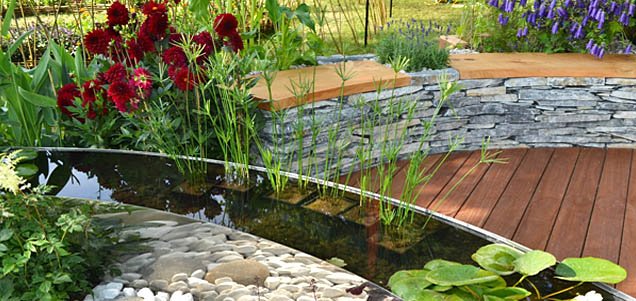
What could be more relaxing than listening to a stream trickle over pebbles or watching ripples gently drift across a lily pond as dragon flies dart from flower to flower? Sounds idyllic doesn’t it? Well, with a bit of help from someone with the right know-how, you can create a water feature in your garden that will provide years of enjoyment and interest from day one.
Before you rush out to buy a pre-formed pond or start to dig a hole in your lawn, there are a few simple steps you should take to ensure your water feature is a blessing and not a burden.
A POND WITH A PURPOSE
The very first thing to consider is why you want water in the garden in the first place.
- Do you want to attract wildlife to your garden and, if so, what?
- Are you interested in adding a greater diversity of plants to your garden by introducing aquatic or marginal species?
- Do you find the sound of running water relaxing and watching ripples and reflections therapeutic?
- Do you have time to spend keeping your water feature exactly how you want it to look or are you happy to let nature take its course?
- Have you got a space in your garden you just don’t know what to do with?
- Do you want to keep fish and, if so, what species?
Once you’re clear about why you want a water feature in your garden, then you can begin to plan the most appropriate type, size and shape.
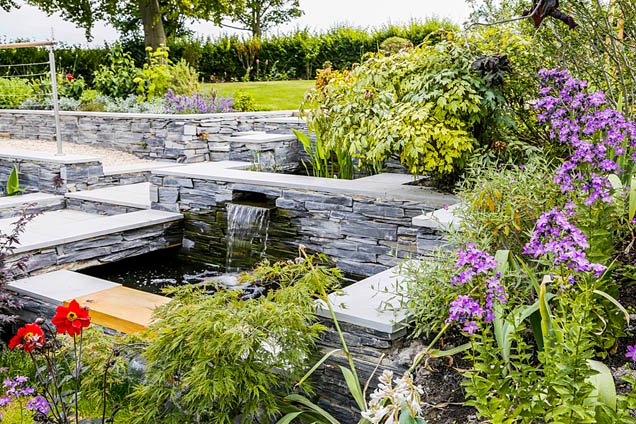
WHAT’S YOUR STYLE – CONTEMPORARY, FORMAL OR NATURAL?
When thinking about the style of water feature, start with the environment it is going to be in. Do you want a sleek and stylish contemporary look to match a modern home, a traditional or formal pond for a more mature garden or perhaps a wilder, naturalistic pond?
Contemporary ponds can be created using pre-fabricated stainless steel that can be commissioned to fit within even the most exacting garden design. They can also be constructed from concrete block, with a flexible liner, faced with stone and then edged with clean, cut coping stones. They can be free standing or form part of the overall structure of the garden to create separate areas or to accommodate changing levels.
Informal, natural ponds normally need a flexible liner and can be anything from a lined scrape in the ground to a lake, depending on room and ambition. Most, like more formal water features, will need a pump to circulate the water and provide vital oxygen. Filtration may be required especially in smaller pools. Larger, deeper pools correctly planted will not need to be filtered, particularly if the aim is primarily as a wildlife habitat.
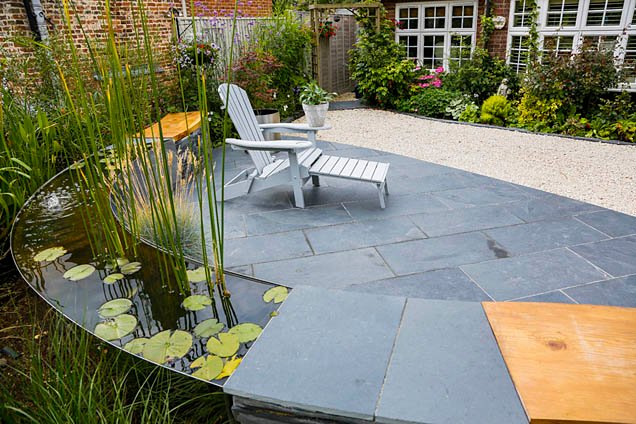
SIGHTS AND SOUNDS OF A WATER FEATURE
Whatever form your water feature takes, it will, inevitably become a focal point in your garden. Water draws interest whether it is a small, formal feature or a large colourful expanse. For many people the sound of running water is very important. A wall-mounted spout into a pool below may suit your formal plan while a bubbling stream over pebbles and rocks works well in a more informal setting.
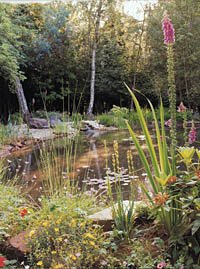 For others it is the planting and aquatic life in and around the water itself which is the attraction and larger more informal pools create the best opportunity for this. Aquatic planting can be divided into four groups:
For others it is the planting and aquatic life in and around the water itself which is the attraction and larger more informal pools create the best opportunity for this. Aquatic planting can be divided into four groups:
- The first is deep water plants such as water Lilies. These are planted on the bottom of the pool and grow up to the surface.
- The second group are marginal plants such as water Irises, Reeds and Pontedaria. These grow best in a few inches of water so shelves around the edge of the pond need to be part of the design.
- Third are the floating plants. These help to provide oxygen, which avoid the build- up of algae. These include Elodea and Water Hawthorn.
- The final and biggest group are the herbaceous plants, which like to have their feet wet or damp; many grasses, sedges and irises fit in to this group.
All of these plants will happily coexist with the wildlife that will be quickly drawn to the water. The only exception to this is that some fish, particularly ornamental fish such as Koi carp, will eat any plants they can reach, so decide early on which you want or you could waste a great deal of money on very expensive plant food!
Small numbers of native fish such as Rudd and Tench are quite happy in a garden pond and help to maintain a natural, balanced environment. It is also possible to keep fish and plants separate should you want both, although it must be designed in at the outset.
FAMILY FUN
Water features can provide a great deal of fun for all the family, so long as they are designed with that in mind. While young children need to be supervised at all times near open water, a marshy bog garden will attract wildlife just as much as a deep pond. Water falling down onto pebbles laid on a metal grid will capture the imagination of children and create a stunning effect at the same time.
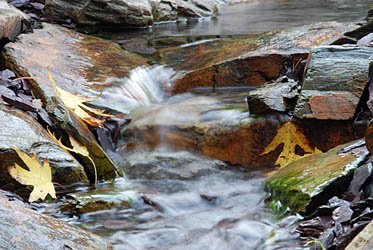
TIME FOR A CHANGE
A well planted large pond could easily take the place of a tired lawn or unused veg patch and transform your garden almost instantly. With careful planning and correct installation, it can really add the ‘Wow’ factor with considerably less work and maintenance than your lawn or veg beds, leaving you to sit back and enjoy it. Aquatic plants do need to be controlled, however, while pumps and filters should be cleaned and liners checked regularly. Water levels may also need to be topped up in warm weather. However, even the biggest water feature can be managed in just a few hours every month or two.
At GreenArt, we’ve been designing and building ponds and water features of all styles and sizes for nearly twenty years – from small containers for your deck to large swimming ponds and woodland streams.
So, what are you waiting for? Get in touch and discuss your ideas with us. Email info@greenart.co.uk or call 01491 280447.








